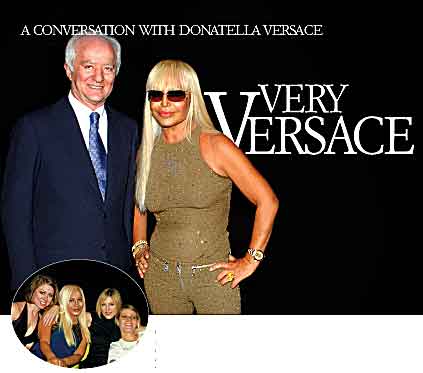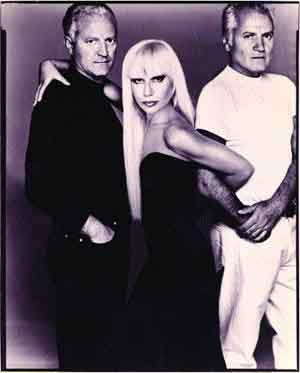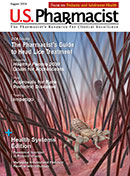|
| |
|
Donatella Versace and Luxottica Group founder and chairman Leonardo Del Vecchio celebrate their new relationship at a party held at the Casa Versace in Milan during MIDO 2003. Inset: At the Versace Atelier 2002, from left Chelsea Clinton, Donatella Versace, Madonna and Gywneth Paltrow. | |
| Once asked in an interview if she ever contemplated changing her trademark white-blonde hair back to its natural color, Donatella Versace responded, “Natural? What is natural? Natural is not about the hair or the face. I do not believe in totally natural for women. Rubbish! For me natural has something to do with food, something to do with vegetables.” Indeed the Versace style is not about simplicity, minimalism or the understated. It breaks the rules innovatively. It’s flash and dash. It’s the allure of sexy rock’n’roll-style glamour. It’s classic design reinterpreted to bold, modern tastes with powerful color palettes, vampish black and liquid fabrics. The Versace customers are men and women with strong personalities—individuals who are self-assured and confident in the lifestyle choices they make—individuals who appreciate distinction and character. Since the founding of the House of Versace by Gianni Versace in 1978, the name has been consistently recognized for its defiant originality and breakthrough designs. In 1983, Gianni Versace was named the top men’s fashion designer in the U.S. In 1993, he was awarded Designer of the year by the CFDA. Upon his death in 1997, his sister Donatella took over the creative reigns of the fashion house and is part owner along with her brother Santo and her daughter Allegra. She is carrying on the Versace tradition, adapting it to a new, more restrained era with a somewhat softer, more modern, organic sensuality that’s just right for today—without ever losing sight of its original flair. She continues to take the House of Versace in new directions and amass awards and honors, including the 2002 MTV Best Designer Award. Versace retrospectives have been presented at New York City’s Metropolitan Museum and at London’s Victoria & Albert Museum in 2002. In 2000, the first of seven planned luxury hotels bearing the Versace name, Palazzo Versace, opened on Australia’s Gold Coast. And Versace has reaffirmed its strong commitment to eyewear, launching ophthalmic and sun collections earlier this year under a new licensing arrangement with Luxottica Group. In an exclusive interview with 20/20, the designer reflects on the house of Versace, her own sense of style and that all-important fashion essential—eyewear. | |
|
|
Donatella with brothers Santo (left) and Gianni. Photograph byRichard Avedon |
What is the design philosophy of the House of Versace and how does it relate to your eyewear? Versace’s designs are, and always have been, noted for being glamorous, sexy and modern, with a constant reference to the world of rock’n’roll. Our eyewear embodies all that: The Versace collection offers more precious detailing and jewel-like elements; Versus has a greater appeal to a younger, more sporty market. What do you think sets the House of Versace apart from other contemporary designers? Versace is all the above, while being uniquely iconographic and hedonistic. Versace is as much rock’n’roll as it is South Beach. Could you comment on both these aspects of the design motivation behind Versace? We certainly have a following from both categories. And if one product can surpass differences in generation, style, class and income— it is our eyewear. How do you feel eyewear has evolved over the past decade? Eyewear has become increasingly homogeneous, so what I try to do is to push away from the pack, offering stronger, unique styles with a particular attention to detailing. Now that you have partnered with Luxottica, what goals have you set for the eyewear? We intend to achieve a turnover of 90 million euros [101.7 million U.S. dollars at press time] in the first 12 months. Indeed we have already more than doubled sales since joining forces with Luxottica in January 2003. In the new eyewear line, there are multiple variations on the Medusa head motif. How do you feel about this evolution? The Medusa motif is a fundamental part of Versace imagery and will always be present in our designs. However, development of our product dictates new variations on the theme be found. This evolution allows our product to appeal to a wider market—not everyone wants obvious brand referencing, whereas others will not buy a product if it doesn’t scream the label out loud. What impact do you think an eyewear license (including prescription eyewear) plays in the big picture for a fashion house? Eyewear is internationally the most widely diffused fashion item we produce and as such its potential to impact worldwide sales is enormous. Eyewear also has another particular importance for a fashion house—a pair of sunglasses or prescription frames ultimately completes a look—they are the finishing touch, especially of the Versace style. What styles of sunglasses do you prefer and why? I wear sunglasses nearly all the time. Big black wrap-arounds in acetate that shout rock’n’roll! What is your favorite new Versace eyewear/sunglass style? The two styles that I sent down the runway during my Fall/Winter ’03-’04 womenswear show—one with split metal temples (model N86) peppered with crystals for an ultra-glamorous look or without for simple, everyday wear) and the super-light, almost frameless style with horizontal oval lenses (model 2006). And for the guys, I love the angular style in acetate (model 4007) that I featured in the Fall/Winter ’03-’04 menswear show. It looks great on the girls too. What is your personal definition of style? The right mix of sensuality and elegance, with plenty of self confidence thrown in. What is/are your favorite color(s)? All ‘pop’ colors and perennial black, of course. What major fashion trends do you expect to see in the next decade? Anything and everything. What advice would you give to a young designer just beginning his or her career? Always follow your own path, your gut-feeling. Never be afraid to take risks. | |
Published August 1, 2003








